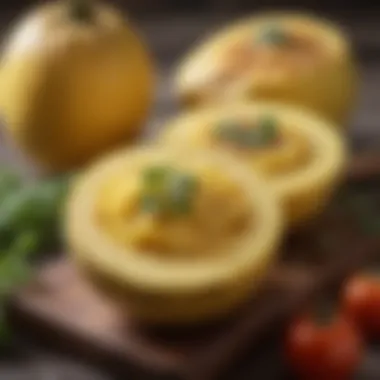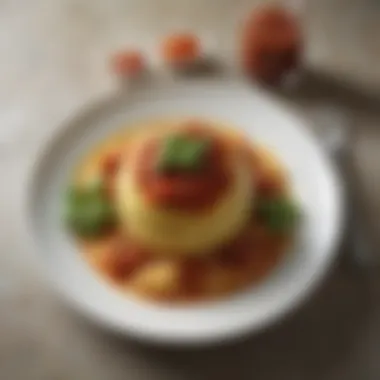A Complete Guide to Cooking Spaghetti Squash Perfectly


Intro
Cooking spaghetti squash can be a transformative experience in the kitchen. This unique vegetable offers a versatile, low-carb alternative to traditional pasta, appealing to both health-conscious individuals and culinary enthusiasts alike. The guide in this article navigates through the various stages from selecting the ideal squash to serving the finished dish in a delightful manner.
Understanding the ins and outs of how to prepare spaghetti squash effectively is key. This includes correct storage, various cooking methods, and truly savoring the inherent flavors of this ingredient. In pressing forward, heed the significance of exploring aspects such as nutritional benefits, time-management strategies, and flavor pairing potentials.
Recipe Overview
Spaghetti Squash Delight
- Number of portions: serves 4
- Time required: 10 minutes prep, 30 minutes cook
- Difficulty: Easy
- Main ingredients: Spaghetti squash, olive oil, garlic, salt, pepper, fresh herbs
This recipe is straightforward and accessible, allowing eager cooks to dive into such a nutritious dish without feeling overwhelmed by complexity.
Step-by-Step Instructions
To make the most out of your spaghetti squash, follow these preparatory and cooking steps precisely:
- Selection: Choose a firm, yellow spaghetti squash. Avoid ones with soft spots or blemishes.
- Prep the squash: Cut the squash in half lengthwise. Scoop out the seeds carefully using a spoon.
- Oil and season: Brush the interior with olive oil, and sprinkle it with salt and pepper.
- Roast: Place the squash cut-side down on a baking sheet. Roast at 400°F for about 30 minutes or until tender.
- Fluff the strands: After cooking, use a fork to gently scrape out the spaghetti-like strands.
- Flavor it up: Sauté garlic in olive oil and mix it with the strands. Optionally, add fresh herbs for extra flavor.
Time-saving strategies might include hastily slicing the squash using a sharp knife, or microwaving whole for a shorter initial cooking time. Alternate methods like using an Instant Pot or slow cooker can also be employed for convenience.
Nutritional Information
Per serving, spaghetti squash provides:
- Calories: Approximately 42 calories
- Protein: 1 gram
- Fats: 0.2 grams
- Carbs: 10 grams
High in vitamin C, potassium, and dietary fiber, spaghetti squash is beneficial for overall health and aids digestion effectively.
Quick Cooking Tips
Utilizing kitchen gadgets can enhance the cooking experience.
- Instant Pot: Follow the "pressure cook" function to prepare evenly cooked noodles in minutes.
- Air Fryer: Roast the squash halves for a crispier texture with adjustable heat settings.
- Multitask: While the squash cooks, chop any desired accompaniments, such as fresh herbs or vegetables.
Consider substituting traditional toppings with lighter alternatives like homemade pesto for a fresh taste or avocado for creaminess.
Related Recipes & Variations
Exploring different accompanying dishes can elevate the entire meal. Consider integrating:
- Marinara sauce for a common favorite.
- Savory sautéed vegetables providing a robust side texture.
- Gluten-free meats or plant-based protein for added sustenance.
Check for adaptations suitable for gluten-free or vegetarian diets. Using diverse seasonings can promote flavor creativity—not all must remain standard. Thus, reflect on personal preferences and creativity by trying your own variations and combinations.
Remember to document and share your unique salad or serving tweaks with the culinary community on platforms like reddit or on Facebook to inspire others.
Spaghetti squash is not only nutritious, but it also opens avenues for gastronomic creativity that cater to varied dietary needs.
Understanding Spaghetti Squash
Spaghetti squash has become a staple for health-conscious cooks and culinary enthusiasts. Understanding the fundamentals about this unique vegetable is crucial for anyone looking to incorporate it into their meals. This section covers the essence of spaghetti squash, the nutritional advantages it offers, and the varieties you might encounter in your culinary journey.
What is Spaghetti Squash?
Spaghetti squash, scientifically known as Cucurbita pepo, is a winter squash that, when cooked, transforms its flesh into spaghetti-like strands. Its pale yellow to golden skin hides the culinary potential it possesses. Many health-conscious individuals appreciate it as a low-carb alternative to traditional pasta, enabling them to enjoy pasta-like dishes without the high carbohydrate count.
The squash is typically oval and can weigh anywhere between 1 to 4 pounds. It sits at the crossroads of nutrition and versatility in the kitchen.
Nutritional Benefits
Spaghetti squash is not just a substitute for pasta; it is a nutritious addition to your diet. Below are some marked benefits:
- Low in Calories: A one-cup serving of cooked spaghetti squash contains approximately 42 calories.
- Rich in Fiber: It has around 10 grams of fiber per serving, aiding in digestive health.
- Vitamins and Minerals: Spaghetti squash is a source of vital nutrients, including vitamins A, C, and B6, along with potassium and manganese, which contribute to overall health.
- Hydration: Due to its high water content, it helps in maintaining hydration.
Incorporating spaghetti squash into your meals offers a meal that is light yet satisfying, aligning well with many dietary goals.


Varieties of Spaghetti Squash
While many might simply think of one type of spaghetti squash, several varieties exist, each with slight nuances affecting flavor and texture. Recognizing these variations can enhance your cooking experience. Some common varieties include:
- Creamy White: Has a slightly sweeter taste and creamier texture than its counterparts.
- Gremlin: This smaller version has a uniquely narrower shape and thick flesh, ideal for personal servings.
- Dunja: A darker-skinned squash, it usually matures faster and has a mild, delicate flavor.
When selecting a variety, consider your dish and personal preference, as each offers distinct culinary possibilities.
Selecting Spaghetti Squash
Selecting spaghetti squash holds significant importance in ensuring the overall quality and taste of the dish you aim to prepare. This section will guide culinary enthusiasts through the intricacies of selecting the perfect squash, focusing on size, color, and freshness. Understanding these elements will enhance your culinary experience and contribute to flavorful, satisfying meals.
Choosing the Right Size and Color
When choosing spaghetti squash, size and color are crucial factors. Spaghetti squash can vary greatly in size, typically ranging from around 2 to 5 pounds. Being aware of the proper size helps in planning your meals. For example, larger squashes might seem appealing, but they're also more fibrous and could take longer to cook. In most cases, opting for medium-sized squash (about 3 pounds) strikes an ideal balance: tender yet substantial enough for a meal.
In terms of color, spaghetti squash should have a consistent, vibrant yellow hue. Look for those with a smooth, slightly glossy skin. Avoid squashes that show signs of dullness or browning, as these indicators may suggest overripeness or potential spoilage. Additionally, some variations exist: it's good to be aware that there are cream-colored and green-colored squashes, but the traditional yellow or golden ones tend to have the best flavor and texture for culinary use.
Freshness Indicators
Recognizing the freshness of spaghetti squash is fundamental to achieving desirable results in your dishes. The first step is to examine the outer skin: healthy squashes should feel firm and solid under your touch. Press your fingers gently against the skin. If it gives easily, this is a sign of overripening.
Next, inspect the ends of the squash. The blossom end—the end opposite the stem—should feel slightly delicate when pressed; this indicates freshness. A very hard end might mean the squash has been picked too early.
Another point of consideration is the overall appearance. Look for blemishes or soft spots; these are negative signs that hint at possible deterioration inside. Always trust your instinct: if a squash looks suspect, it's better to leave it and seek a Fresher option, contributing to better culinary outcomes.
Remember: Selecting high-quality ingredients is key to achieving flavor. Spend time in the produce section to ensure you're choosing the best spaghetti squash.
Preparation Techniques
Preparation techniques are vital to making the most of spaghetti squash. Effectively cleaning and cutting preparation helps achieve a texture that resembles pasta, which is the ultimate goal of cooking this unique vegetable. Proper techniques improve not just the aesthetic but also the flavors etched into the dish.
Cleaning the Squash
Cleaning spaghetti squash is a crucial first step. Before you start cooking, it is essential to remove any dirt or debris on the surface. Often, groceries may contain residual pesticides or dirt that can alter the taste and health properties of the squash.
The cleaning process involves:
- Rinsing the squash under cool running water.
- Gently scrubbing it with your fingers or a vegetable brush to eliminate any stubborn particles.
- Drying it with a clean towel or air drying it afterward.
This step ensures that the spaghetti squash is ready for cooking while also safeguarding your health.
Cutting Methods
Choosing how to cut spaghetti squash affects cooking time and the texture of the resulting strands. There are two popular methods of cutting this squash: Halving and Quartering. Each approach offers distinct benefits.
Halving
Halving the squash involves cutting it from stem to base. This method gains popularity due to its simplicity and efficiency in allowing easy access to the seeds. The main characteristics of halving are its ability to:
- Limit overall cooking time in the oven or microwave.
- Create larger strands of 'noodle,' which mimics traditional pasta shape.
While giiving potentially longer noodle threads, halving can be somewhat more difficult as the squash can be tough. This method requires careful execution of wielding a sharp knife to ensure safety and accuracy.
Quartering
Quartering is another effective method where the squash is cut into four sections, allowing more uniform cooking. Each piece, when cut carefully, can fit neatly into a steamer or Instant Pot. Here are key aspects regarding quartering:
- It speeds up cooking because smaller pieces can lose steam quicker.
- Quartering results in stranded that are shorter and may pair better with certain sauces.
Despite promoting even cooking, quartering helps unravel the spaghetti squash strands with some improved character. The downside is that smaller strands might lose texture, resembling overcooked pasta indicating the need for careful monitoring.
In summary, preparation techniques act as the bedrock of preparing spaghetti squash. Knowing how to properly clean and cut can make a significant impact on flavor and eating experience.
Cooking Methods for Spaghetti Squash
Cooking spaghetti squash successfully requires understanding various methods that suit both preferences and time constraints. This section explores distinct cooking methods for spaghetti squash, highlighting their advantages and considerations, thereby allowing readers to choose the one that best fits their needs.


Roasting in the Oven
Preparing the Oven
Preparing the oven involves preheating it before roasting spaghetti squash. This step ensures even cooking, which makes a significant difference in texture and flavor. One key characteristic of this method is the ability to brown the squash, creating a rich, nutty flavor. This is a popular choice as it enhances the natural sweetness of the squash while allowing moisture to escape, resulting in firmer strands of the flesh.
A unique feature of preparing the oven is the use of seasonings or other oils. This contributes to flavor complexity, making it a deeply personalized cooking approach. However, it does demand a longer time, which might not be advantageous for all.
Cooking Time and Temperature
Cooking time and temperature are crucial aspects of achieving desired results when roasting spaghetti squash. For best outcomes, a temperature of around 400°F typically works well, offering a balance between cooking thoroughly and attaining crispy edges. The cooking time usually ranges from 30 to 45 minutes, depending on the squash size.
The key characteristic of this approach is its versatility, letting home cooks adjust the time based on how soft or caramelized they wish their squash to be. This method also may yield a slight downside: overcooking can lead to mushiness if not monitored.
Microwave Cooking
Time Efficiency
Time efficiency is one of the major reasons for utilizing the microwave method for spaghetti squash. This approach significantly reduces cooking time, often allowing it to be cooked in 10 to 15 minutes. One characteristic that makes the microwave attractive is its convenience, enabling swift meal preparation in busy household.
The unique feature of eventual texture here can differ from oven-roasted squash, often resulting in a more subdued flavor but still edible as a nutritious alternative. While this method is efficient, potential downsides include watching for uneven cooking, which may leave some areas undercooked if not managed.
Steps to Follow
The steps to follow when microwaving spaghetti squash are straightforward and facilitate the cooking process effectively. After washing and preparing the squash, place it in a microwave-safe dish. It’s advisable to pierce the skin in multiple locations allowing steam to escape.
The simplicity of these steps contributes to its popularity, as even novice cooks find this method accessible. However, the main concern here can be in balancing cooking time; rush can lead to undesirable textures.
Instant Pot Method
Setting Up the Instant Pot
Setting up the Instant Pot for cooking spaghetti squash is quite convenient. This method often reduces cooking time drastically compared to traditional methods. The setting is simple, usually choosing the “steam” function or “high pressure” allows for thorough cooking in a matter of minutes.
An important characteristic of the Instant Pot is the sealed environment which retains flavors and moisture better than many other methods. Its unique feature means flavors will usually be intensified, leading to enjoyable outcomes despite a steep learning curve for some. While this method proves quick, issues can arise regarding proper sealing, which may need familiarity.
Recommended Cooking Times
Recommended cooking times in the Instant Pot are another crucial factor. Typically, a cooking time of about 7 to 10 minutes is sufficient for a medium-sized spaghetti squash. Based on size and moisture content, some minor adjustments may be necessary, highlighting versatility and adaptation inherent to this method.
The key characteristic lies in how the pressure can transform hard, raw squash into areas of delicious strands. Though it may not allow for caramelization as roasting does, the amount of flavor retained still makes this method competitive.
Overall, selecting a cooking method for spaghetti squash largely depends on individual time management needs, available kitchen setups, and personal preference.
How to Serve Spaghetti Squash
Serving spaghetti squash properly enhances the dining experience significantly. The way a dish is presented affects both its visual appeal and the reader’s perception of flavors. Knowing how to serve spaghetti squash ensures that its texture and taste shine. From appropriate flavors to meal combinations, understanding these elements could lead to more satisfying meals.
Flavors that Compliment
Spaghetti squash is known for its mild taste, which makes it adaptable to many flavors. Choosing the right sauces and toppings can elevate this vegetable into a gourmet dish. Tomato sauces, especially rich marinara or roasted tomato variants, provide a classic option. The acidity and sweetness in tomatoes balance well with the squash.
Herbs and spices also play a vital role. Fresh basil, oregano, and thyme are ideal choices to sprinkle over the dish, enhancing its aroma and flavor profile. For those who enjoy notion different flavors, garlic and red pepper flakes can introduce depth.
Cheese is another popular companion. Adding parmesan, mozzarella, or even feta can lend creaminess and additional complexity. Thus, one can combine these accents, creating a personalized serving style to allure individual tastes.
Storing and Reheating Spaghetti Squash
Proper management of spaghetti squash after cooking is crucial for maintaining its quality and taste. Storing and reheating this unique vegetable correctly ensures that you can enjoy leftovers without sacrificing flavor or texture. Here is what you need to consider to preserve the integrity of your dish.
Proper Storage Techniques
To store spaghetti squash effectively, start by letting it cool down to room temperature if it has been cooked. Leaving it out for about 30 minutes is typically sufficient. Once it is temperate, you can place any leftovers in an airtight container. This practice will prevent moisture loss and help to avoid the absorption of unwanted odors from other foods in your fridge.
- Whole Squash: If you have leftover whole, uncut spaghetti squash, it can be stored in a cool dry place, often on your counter. Keeping it away from direct sunlight is important, and it can last for up to a month.
- Cooked Squash: For cooked spaghetti squash, it is best stored in the refrigerator. Ideally, you should consume the leftovers within three to five days to appreciate its quality, but many may wondder if they can hold on for longer. If freezing is necessary, ensure it is in a freezer-safe container or may noted freezer bags. However, it is worth considering that freezing could change the texture
Note that while it is possible to freeze, it is not always recommended, as it can often lead to watery squash when thawed.


Reheating Tips
When it comes time to enjoy your stored spaghetti squash again, reheating properly is key. Slight alterations in temperature and technique can optimize and enhance the flavor, preserving its original appeal. Here are various methods to do so:
Microwave Method
Should you desire a rapid approach, reheating in the microwave is the most efficient. Place squash inside a microwave-safe bowl, adding a splash of water to keep it moist while heating. Cover with a lid or microwave-safe plate to trap steam and warm evenly:
- Heat for about 1 to 2 minutes, stirring midway, until the squash is thoroughly heated.
Stove Top Method
For more flavor retention, you may opt for the stove top method. In a pan over medium heat, add a bit of olive oil or butter, followed by the spaghetti squash. Stir occasionally, letting it warm up gently to retain the taste.
- Expect this to take around 5-7 minutes depending on the portion.
Oven Method
Should you have a substantial batch to reheat, the oven method is also viable. Preheat your oven to 350°F. Spread the spaghetti squash on a baking sheet, lightly covered with foil to avoid excessive drying:
- The squash usually takes 15-20 minutes to heat through.
By applying these storage and reheating tactics, you ensure that each spaghetti squash meal retains its seasoned flavors and squashy texture—the clear pathway for a delightful gourmet experience, even days after preparing it.
Common Mistakes to Avoid
Cooking spaghetti squash, though straightforward, can lead to some common pitfalls that affect both texture and flavor. Addressing these mistakes can greatly enhance the experience and outcome of your culinary efforts. Understanding what to avoid allows you to enjoy the dish fully and ensures satisfaction for you and your diners.
Overcooking
Overcooking is one of the most frequent errors when preparing spaghetti squash. The natural delicate texture can quickly turn mushy. This mishap not only dislodges the familiar spaghetti-like strands of the squash but can also diminish the flavor profile significantly.
When roasted or cooked for too long, spaghetti squash can readily slide into a less desirable state, reminiscent of an overdone vegetable mush. A proper cooking time usually lays between 30 to 45 minutes in the oven, depending on the method selected. If cooking in the microwave, keep an eye on the timer, as it can cook faster than expected.
To ensure ideal doneness, always check for a slight fork-tender texture without significant pressure. A useful way to gauge readiness is by gently twisting a fork into the strands; if they break apart easily, it indicates they are ready.
How to Avoid Overcooking:
- Set a timer when cooking.
- Continuously monitor your squash especially during the last few minutes.
- If using the oven, give it a visual check instead of relying solely on cooking times.
Remember, it is easier to cook more than to rectify overcooked vegetables.
Under-seasoning
A common related error is under-seasoning. Spaghetti squash has a naturally mild flavor, which can easily be overshadowed if spices and seasonings are not applied thoughtfully. Failure to adequately season can lead to a bland dish that fails to excite the palate.
Your approach should build on applying flavors that complement the naturally nutty taste of the squash. When preparing spaghetti squash, aim for a balance between seasoning and the natural flavors. Salt, pepper, garlic, herbs, and zesting ingredients can elevate the dish.
Tips for Correct Seasoning:
- Taste your dish as you go along.
- Use a variety of seasonings to enhance and create depth, like chili flakes for heat or olive oil for richness.
- Consider finishing touches, such as a pinch of Parmesan cheese or a drizzle of balsamic glaze to elevate the flavor.
Finale
The conclusion of this guide emphasizes the intricate yet rewarding experience of cooking spaghetti squash. This vegetable is not merely an alternative to pasta; it embodies a healthier lifestyle with rich textures and capabilities in culinary applications.
Cooking spaghetti squash successfully is about understanding its characteristics, naturally integrating seasoning, and mastering cooking methods. These aspects are essential to avoiding common pitfalls like overcooking and under-seasoning. Proper attention to these details can yield a flavorful and satisfying dish, which aligns with dietary goals and preferences.
Some key takeaways about cooking this vegetable include:
- Knowing how to select a fresh spaghetti squash ensures better taste and texture.
- Mastering various cooking techniques opens up different avenues for flavors and presentation.
- Appropriate storage extends the life of your cooked squash, reducing waste and maximizing efficiency in meal prep.
By developing a repertoire of hints and methods detailed throughout this guide, you can enhance your cooking skills while providing nutritious alternatives on your plate. This entire process is a valuable addition to your culinary repertoire, catering to not just low-carb needs, but also showcasing versatility in your kitchen endeavors. Taking the time to learn and appreciate the nuances of spaghetti squash ultimately enhances the joy of cooking.
Final Thoughts on Cooking Spaghetti Squash
As you embark on your journey with spaghetti squash, remember its adaptability as your companion in the kitchen. This squash absorbs flavors remarkably well, serving as a perfect base for both simple and elaborate meals.
Whipping up comforting dishes, experimenting with different cuisines, or creating a lighter option for your favorite pasta dishes can all be possibilities at your fingertips. Consider a few flavor pairings:
- Tomato Sauce: A classic choice, merging well with spaghetti squash.
- Pesto: Adds sophisticated taste with minimal effort.
- Garlic and Olive Oil: This brings elegance and robustness when simply sautéed.
When you wrap up a meal featuring spaghetti squash, take note of your results. Each encounter contributes to your understanding, refining your culinary skills further. Hence, investing thought and practice into your cooking methods can make an ordinary meal into a delightful culinary experience.
Your exploration of spaghetti squash is a reflection of your personal journey with food. Appreciate every stage of preparation; each one count.Putting practical application to work offers remarkable benefits in sustainability and health. Enjoy the varieties available and enjoy building your own unique tradition in cooking with this underrated squash.







